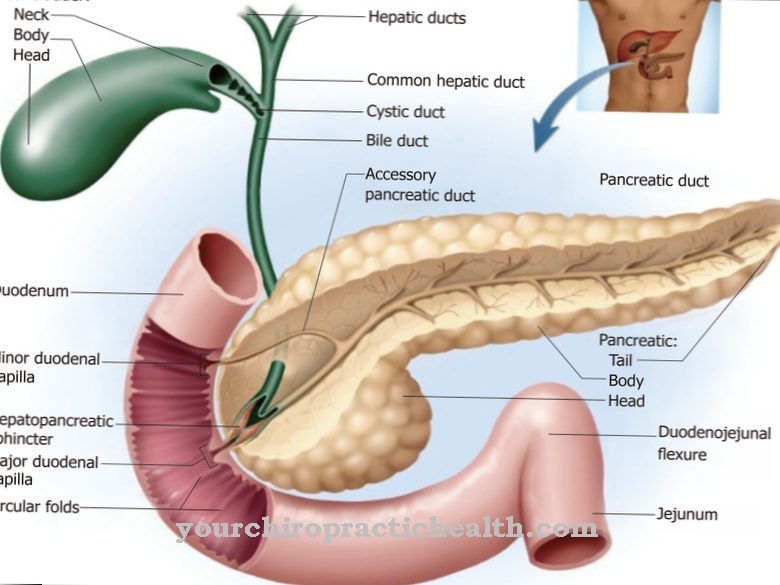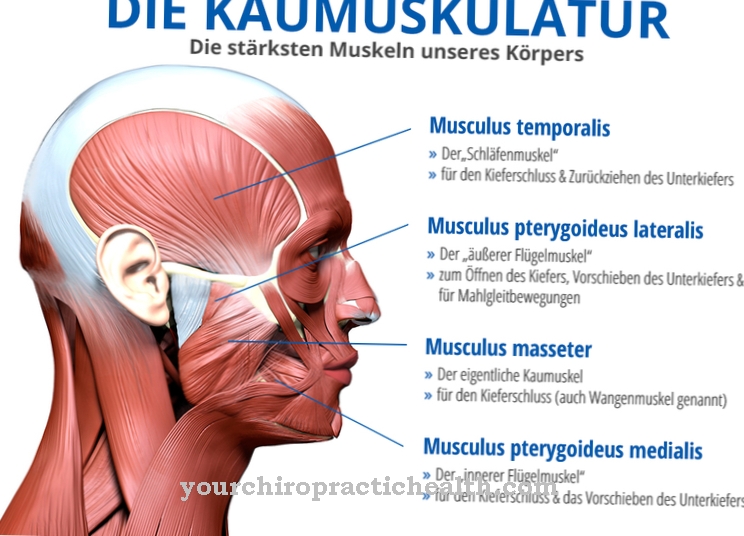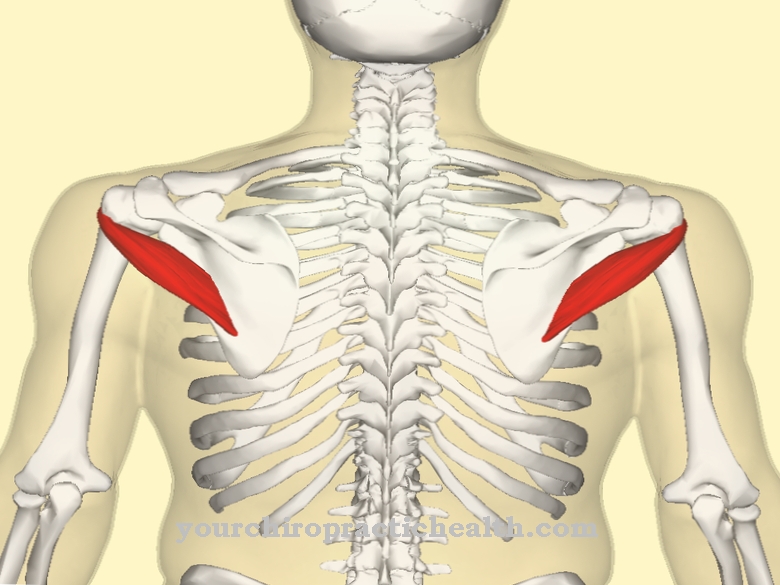Of the Pharyngis medius constrictor muscle is a throat muscle and consists of two parts. It is responsible for constricting the pharynx and thereby pushing food or fluid to the gullet (esophagus). Functional restrictions of the musculus constrictor pharyngis medius often show up in swallowing and speech disorders.
What is the pharyngis medius constrictor muscle?
The musculus constrictor pharyngis medius belongs to the throat muscles and is one of the throat constricters within this group. The upper pharyngeal constrictor muscle (Musculus constrictor pharyngis superior) and the lower pharyngeal constrictor (Musculus constrictor pharyngis inferior) connect directly to the Musculus constrictor pharyngis medius on both sides, but represent anatomical units that can be separated from it.
The three muscles develop in the embryonic stage from different gill arches, whereby the musculus constrictor pharyngis medius arises from the fourth gill arch. This also contains the systems for the inner and outer muscles of the larynx (larynx muscles), muscles of the esophagus and various vessels, nerves and cartilage. The other two throat cords develop from the third and sixth gill arches.
The musculus constrictor pharyngis medius belongs to the skeletal muscles and can be deliberately influenced. It also has a striated structure, the pattern of which is created by alternately arranged filaments within the muscle fibers.
Anatomy & structure
Anatomically, the middle pharyngeal constrictor can be divided into two areas: the pars ceratopharyngea and the pars chondropharyngea.
Both parts of the musculus constrictor pharyngis medius arise from the hyoid bone (os hyoideum), but have their origin there in different places: the pars ceratopharyngea begins on the small horn (cornu majus), whereas the pars chondropharyngea arises from the large horn (cornu minus). The hyoid bone (corpus ossis hyoidei) extends between the two horns. The hyoid bone does not have its own connection to other bones, but is attached to the suprahyoid and infrahyoid muscles as well as some throat and tongue muscles.
The insertion of the musculus constrictor pharyngis medius is located at the throat suture (raphe pharyngis). This is also where the upper and lower throat cords start. Overall, the musculus constrictor pharyngis medius has the shape of a fan or funnel. Nerve fibers connect the muscle to the pharyngeal plexus, which consists of branches of the ninth cranial nerve (glossopharyngeal nerve) and parts of the tenth cranial nerve (vagus nerve).
Function & tasks
The pharyngis medius constrictor muscle participates in the swallowing process and contributes to the formation of certain sounds, including posterior low vowels and pharyngeal sounds.
The act of swallowing can be divided into a preparatory phase, which includes chewing, for example, and three transport phases. During the oral transport phase, the tongue muscles are particularly active and push the food or liquid from the front of the mouth into the throat. This is followed by the pharyngeal transport phase, which is crucial for the pharyngis medius constrictor muscle.
First, the tensor veli palatini muscle and the levator veli palatini muscle tighten the soft palate. The muscle constrictor pharyngis superior creates a bulge in the nasopharynx (epipharynx) by contraction, which is also known as Passavant's ring bulge. This, together with the soft palate, closes the access to the nose. The digastric muscle, the mylohyoid muscle and the stylohyoid muscle pull or lift the hyoid bone together with the infrahyoid and suprahyoid muscles upwards. At the same time, the thyrohyoid muscle also lifts the larynx so that the epiglottis can close it.
At the same time, the upper esophageal sphincter dilates the esophagus. The ring-shaped sphincter is located in the upper esophageal constrictio (pharyngooesophageal constriction) and forms the mouth of the esophagus. When all airways are closed, the pharyngeal constrictor muscle contracts, pushing the food or fluid further back in the throat. The inferior pharyngeal constrictor muscle supports him in this. In the subsequent oesophageal transport phase, the muscles of the esophagus finally take over the further transport to the stomach. The whole process is highly automated and controlled by the swallowing center of the brain.
You can find your medication here
➔ Medication for heartburn and bloatingDiseases
Damage to the musculus constrictor pharyngis medius rarely occurs in isolation, but often affects the other throat muscles and other structures as well. Functional failures of the muscle are often caused by neurons. Swallowing disorders, also known as dysphagia, can affect all phases and aspects of the act of swallowing: from closing the nose and larynx to lifting the hyoid bone and pushing food forward. Sensitivity and salivation may also be affected.
There are numerous possible causes of dysphagia. In addition to direct injuries (e.g. from an accident), nerve damage is the most common reason. Radiation therapy to treat breast cancer can inadvertently damage the pharyngeal plexus, which also controls the median pharyngeal constrictor muscle. The vagus nerve and the glossopharyngeal nerve, together with the accessory nerve, cross the zygomatic vein hole (foramen jugulare), through which blood vessels also run.
Tumors, bleeding, swellings, injuries and other damage at this point therefore often affect all three nerves and accordingly trigger very complex clinical pictures. Neuromuscular and neurodegenerative diseases can also affect the fibers that control the pharyngeal constrictor muscle. This also applies to brain injuries and circulatory disorders such as strokes and congenital neuroanatomical abnormalities.
Since the musculus constrictor pharyngis medius is not only involved in the swallowing process, but also contributes to the formation of certain sounds, motor speech disorders are also possible. Under certain circumstances, those affected can improve their speaking skills again through speech therapy training. However, the success depends on the individual case at hand.



























